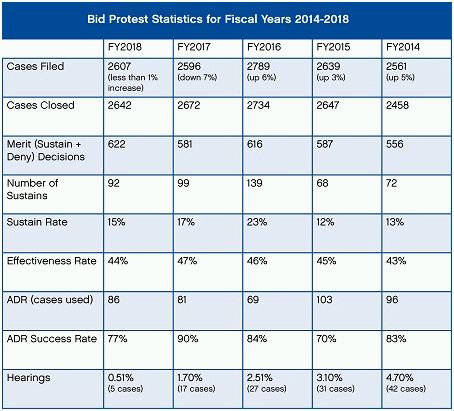In Short
The Issue: The U.S. Government Accountability Office ("GAO") recently issued its Fiscal Year 2018 ("FY18") end-of-year summary statistics.
The Outcome: The number of cases filed, the sustain rate, and the effectiveness rate remained largely consistent with previous years. The statistics lend further credence to the notion that FY16, in which the GAO's sustain rate doubled, was an outlier.
On November 27, 2018, the GAO released its Bid Protest Annual Report for FY18 to Congress. This report featured the bid protest statistics for FY14 to FY18, as well as each instance in which a federal agency did not fully implement a GAO bid protest recommendation made in the prior fiscal year.
The percentage of bid protests that were sustained (the sustain rate) dropped to 15 percent this year. This figure continued a downward trend seen over the last two years, when the rate dropped from 23 percent to 17 percent. As the years progress, the FY16 figure of 23 percent looks more like an outlier, as GAO's sustain rate has returned to the mid-teens.
As we have noted previously, perhaps the more important figure from the annual report is the overall effectiveness rate. GAO's effectiveness rate represents the percentage of protests in which a protester obtained some form of relief—either through a decision sustaining the protest or through an agency voluntarily taking corrective action. The FY18 effectiveness rate was 44 percent, declining slightly from previous years. However, this figure nevertheless demonstrates that with the right grounds, many protestors can still find success through a GAO protest.
Another noteworthy statistic relates to hearings held by GAO. That number has continued its decline to historic lows. Never a statistically significant number, only five cases (or .51 percent) received a hearing this year, down from 42 cases (4.70 percent) five years ago. This is the only statistic included in the report that shows a consistent decline year on year.
Finally, GAO's annual report also informs Congress of each instance in which a federal agency did not fully implement one of GAO's recommendations in connection with a bid protest decided in the prior fiscal year. This year, as last year, GAO reported that there were no such instances—agencies followed every recommendation that GAO made. The fact that agencies followed every single GAO recommendation last year highlights the significance of GAO as a bid protest forum and the value of GAO's bid protest decisions.

Two Key Takeaways
- Although the effectiveness rate dropped slightly this year, protesters still obtained some form of relief in 44 percent of protests filed with GAO. This indicates that GAO protests remain a useful tool to challenge the violation of procurement laws and regulations.
- The fact that agencies followed every recommendation GAO made last year demonstrates that GAO's decisions carry great weight, even though they are nonbinding.
The content of this article is intended to provide a general guide to the subject matter. Specialist advice should be sought about your specific circumstances.


